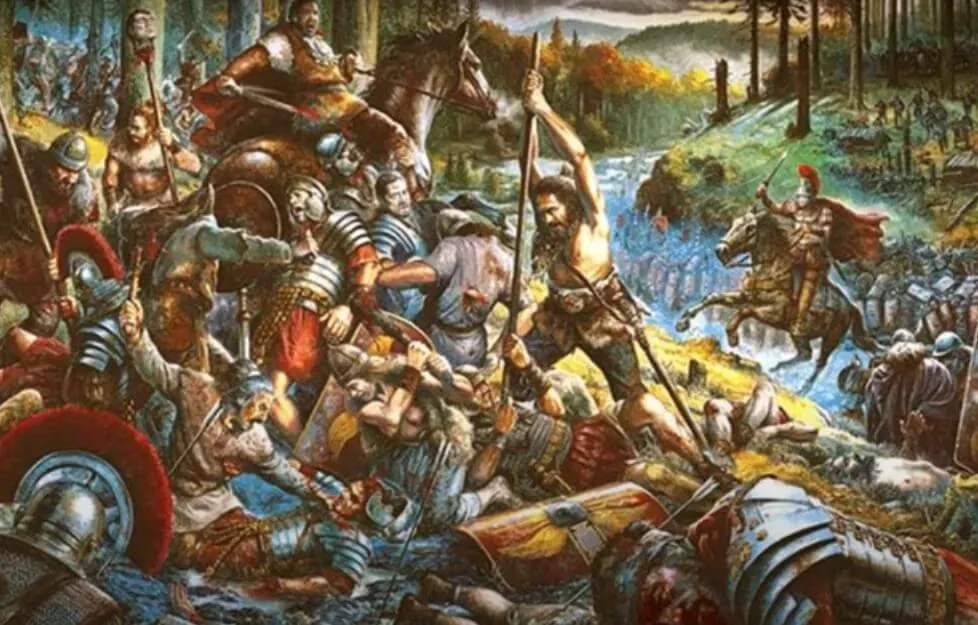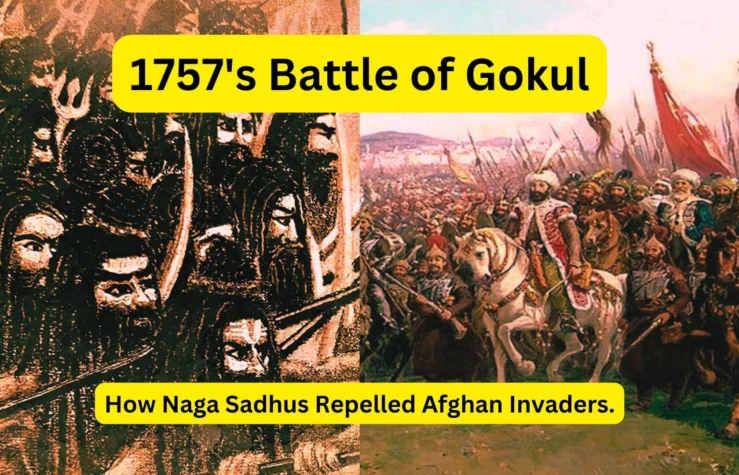Introduction
The Battle of Gokul in 1757 stands as a testament to the resilience and valor of the Naga Sadhus, who defended their sacred land against formidable adversaries.
Historical Context
In the mid-18th century, India was a mosaic of regional powers, with the Mughal Empire’s influence waning and external threats looming large. Ahmad Shah Abdali, the founder of the Durrani Empire, launched multiple invasions into India, driven by ambitions of expansion and plunder. His campaigns were marked by significant violence, including the infamous sacking of Delhi and the brutalities in Mathura and Vrindavan.
Significance in Indian History
The Battle of Gokul is particularly noteworthy for the unexpected and fierce resistance mounted by the Naga Sadhus. These ascetic warriors, traditionally detached from worldly affairs, took up arms to protect their sacred spaces and communities. Their victory against a numerically superior and battle-hardened Afghan force not only safeguarded Gokul but also inspired subsequent resistance movements against foreign invasions. This battle exemplifies the profound commitment to dharma (duty) and the defense of cultural and religious heritage, leaving an indelible mark on the annals of Indian history.
Political and Social Conditions Leading Up to the Battle
The period was characterized by political fragmentation and social upheaval. The decline of centralized Mughal authority created a power vacuum, leading to increased incursions by external forces like Abdali’s Afghans. The religious sanctity of places like Gokul, Mathura, and Vrindavan made them targets for plunder, as they housed temples with considerable wealth and were centers of Hindu devotion. The local populace, including ascetic orders such as the Naga Sadhus, were compelled to transition from spiritual pursuits to martial defense in response to these threats.
Key Players and Factions Involved
- Ahmad Shah Abdali: A prominent Afghan ruler and military leader, Abdali sought to assert his dominance over Northern India, driven by both expansionist ambitions and the lure of wealth.
- Naga Sadhus: Ascetic warriors belonging to the Dashanami monastic tradition, established by Adi Shankaracharya. Foreseeing future threats to Hinduism, he organized these sadhus into militant groups to protect religious sanctuaries and uphold dharma. Their rigorous training and unwavering commitment made them formidable defenders.
- Local Hindu Communities: The residents of Gokul and surrounding areas, whose lives and religious freedoms were directly threatened by the invasion, played a crucial role in supporting the resistance against Abdali’s forces.
The convergence of these factors and players set the stage for a confrontation that would highlight the profound interplay between spirituality and martial prowess in India’s history.
The Historical Context
Gokul’s Importance
Geographical and Strategic Significance of Gokul
Gokul, situated along the Yamuna River in present-day Uttar Pradesh, India, holds a position of both geographical and strategic importance. Its proximity to Mathura, a major urban center, and its location along ancient trade routes enhanced its accessibility and economic significance. The fertile plains surrounding Gokul supported agriculture, contributing to the region’s prosperity. Strategically, Gokul’s position near the Yamuna provided a natural defensive advantage, with the river acting as a barrier against potential invasions from the west.
Cultural and Religious Relevance
Gokul is deeply embedded in Hindu religious tradition as the early childhood abode of Lord Krishna. According to sacred texts, it was here that Krishna was nurtured by his foster parents, Yashoda and Nanda, and performed numerous divine pastimes (leelas). This association renders Gokul a significant pilgrimage site, attracting devotees seeking spiritual connection with the life of Krishna. The town’s temples and ghats (riverfront steps) serve as focal points for religious ceremonies and festivals, reinforcing its status as a center of Vaishnavite devotion.
The Rise of the Mughal Empire
Expansion Policies of Aurangzeb
Emperor Aurangzeb, who reigned from 1658 to 1707, pursued aggressive expansionist policies to consolidate and extend the Mughal Empire’s dominion across the Indian subcontinent. His military campaigns targeted the annexation of independent kingdoms in the Deccan and the suppression of regional powers that resisted Mughal authority. Aurangzeb’s reign was marked by a shift towards orthodox Islamic practices, influencing his administrative decisions and interactions with non-Muslim subjects. He reinstated the jizya tax on non-Muslims and implemented measures that affected Hindu religious institutions, such as restrictions on temple construction and the destruction of certain temples. These policies were intended to reinforce Islamic principles within his realm but also led to increased tensions with non-Muslim communities.
Tensions Between Mughal Rulers and Local Powers
Aurangzeb’s centralization efforts and religious policies exacerbated tensions between the Mughal administration and regional entities. Local rulers, particularly in Rajputana and the Deccan, perceived the emperor’s actions as encroachments on their autonomy and traditional practices. The imposition of stricter Islamic laws and the marginalization of non-Muslim elites disrupted the previously accommodative Mughal approach, which had allowed for a degree of religious and cultural pluralism. This shift led to rebellions and sustained resistance from various quarters, including the Marathas under Shivaji and Rajput clans, who sought to preserve their sovereignty and cultural identity. The resulting conflicts strained the empire’s resources and contributed to its eventual decline, as prolonged military engagements and administrative overreach weakened central authority and fostered regional fragmentation.
Understanding Gokul’s significance and the broader historical dynamics of Aurangzeb’s reign provides insight into the complex interplay of geography, culture, and politics that shaped the region’s history during this period.
Key Figures
Aurangzeb
His Role and Motivations for Attacking Gokul
Emperor Aurangzeb, who reigned over the Mughal Empire from 1658 to 1707, was known for his expansionist policies and efforts to enforce Islamic orthodoxy. His reign was marked by numerous military campaigns aimed at consolidating Mughal authority across the Indian subcontinent.
In the late 1660s, Aurangzeb’s attention turned towards the Braj region, encompassing sacred Hindu sites such as Mathura, Vrindavan, and Gokul. His motivations for targeting this area were multifaceted:
- Religious Policy: Aurangzeb sought to reinforce Islamic principles within his realm, which led to actions against Hindu religious institutions. This included the destruction of temples and the imposition of the jizya tax on non-Muslim subjects. The Braj region, with its significant Hindu temples and active devotional communities, became a focal point for these policies.
- Suppression of Rebellion: The region was also home to the Jat community, who had begun organizing rebellions against Mughal authority, partly in response to Aurangzeb’s religious policies. Leaders like Gokula, a prominent Jat figure, led uprisings that challenged Mughal control. Aurangzeb’s campaigns in the area aimed to suppress these rebellions and reassert imperial dominance.
Aurangzeb’s actions in the Braj region, including Gokul, were thus driven by a combination of religious zeal and the imperative to quell dissent against his rule.
Local Leaders
Resistance Leaders from Gokul
The Braj region, particularly Gokul, was home to several leaders who resisted Mughal incursions:
- Gokula Singh: A prominent Jat leader from the village of Tilpat, Gokula led a significant rebellion against Aurangzeb’s forces in 1669. Motivated by oppressive taxation and religious persecution, he mobilized local communities to defend their land and faith. Despite initial successes, Gokula was eventually captured and executed, but his legacy inspired continued resistance in the region.
- Raja Ram Jat: Following Gokula’s martyrdom, Raja Ram Jat emerged as a key figure in the resistance against Mughal authority. In a bold act of defiance, he plundered the tomb of Emperor Akbar, symbolizing the deep resentment towards Mughal policies. His leadership helped the Jats maintain their spirit of rebellion, which ultimately led to the creation of the independent state of Bharatpur.
Other Prominent Figures Who Played a Role in the Battle
In addition to the Jat leaders, the Naga Sadhus, a militant ascetic order, played a crucial role in defending Gokul:
- Rajendra Giri Gosain: A revered leader among the Naga Sadhus, Rajendra Giri Gosain was renowned for his bravery and martial prowess. Under his command, the Nagas confronted invading forces, including those led by Ahmad Shah Abdali in 1757. Their commitment to protecting sacred Hindu sites was instrumental in repelling attacks and preserving the cultural heritage of the region.
These leaders exemplified the resilience and determination of the local populace in the face of external threats, leaving an enduring legacy in the history of Gokul and the broader Braj region.
The Course of the Battle
Pre-Battle Events
Preparations by Both Sides

In 1757, Ahmad Shah Abdali, leading a formidable Afghan force, advanced into the Braj region, targeting sacred Hindu sites for their wealth and symbolic significance. After devastating Mathura and Vrindavan, Abdali’s forces set their sights on Gokul, renowned for its association with Lord Krishna. Anticipating the threat, approximately 4,000 Naga Sadhus, ascetic warriors established by Adi Shankaracharya, mobilized to defend the town. Their preparations involved rigorous martial training and strategic positioning to leverage their intimate knowledge of the local terrain.
Strategic Moves Leading to the Confrontation
Abdali dispatched a contingent of 20,000 soldiers under Commander Sardar Khan to capture Gokul. The Naga Sadhus, aware of the approaching army, fortified key entry points and utilized guerrilla tactics to compensate for their numerical disadvantage. Their strategy focused on ambushes and exploiting the invaders’ unfamiliarity with the landscape, aiming to disrupt the cohesion of the Afghan forces.
The Battle Itself
Detailed Description of the Battle
As Sardar Khan’s troops advanced towards Gokul, they encountered the Naga Sadhus, who, despite their ascetic lifestyle, were formidable warriors. The battle commenced with the Nagas launching a fierce offensive, their unconventional appearance and combat style sowing confusion among the Afghan ranks. The Sadhus’ intimate knowledge of the terrain allowed them to execute effective hit-and-run attacks, disrupting the enemy’s formations.
Key Moments and Turning Points
The initial underestimation of the Naga Sadhus by Sardar Khan proved detrimental. As the battle progressed, the relentless assaults by the Nagas inflicted significant casualties on the Afghan forces. Requests for reinforcements were met, but even additional troops failed to break the Sadhus’ defense. The psychological impact of facing such determined and unconventional adversaries eroded the morale of the Afghan soldiers, culminating in a retreat ordered by Sardar Khan to preserve the remnants of his force.
Immediate Aftermath
Consequences for the People of Gokul
The victory of the Naga Sadhus safeguarded Gokul from the devastation that befell neighboring towns. The preservation of their homes and temples reinforced the community’s faith and resilience. The successful defense also elevated the status of the Naga Sadhus, who were revered as protectors of the sacred land.
Reactions from Surrounding Regions
The unexpected defeat of Abdali’s forces by a smaller, ascetic group resonated throughout the region. It inspired other communities to resist foreign invasions and bolstered the morale of indigenous forces opposing external threats. The battle underscored the effectiveness of unconventional warfare and the profound impact of spiritual conviction in martial conflicts.
The Impact of the Battle
On the Mughal Empire
Short-term and Long-term Effects on Aurangzeb’s Policies
The Battle of Gokul, occurring during Aurangzeb’s reign, had significant implications for the Mughal Empire’s policies:
- Short-term Effects: The resistance encountered at Gokul, particularly from the Naga Sadhus and local defenders, highlighted the challenges of enforcing imperial authority in regions with strong local identities and religious significance. This resistance may have prompted Aurangzeb to reassess the immediate implementation of certain policies in similarly resistant areas, recognizing the potential for local uprisings.
- Long-term Effects: Aurangzeb’s reign was characterized by strict religious policies, including the imposition of the jizya tax on non-Muslims and the destruction of Hindu temples
The resistance at Gokul and similar events across the empire contributed to growing dissent among non-Muslim subjects. Over time, these policies strained the empire’s administrative and military resources, as continuous suppression of uprisings became necessary. The cumulative effect of such resistance movements is considered a factor in the eventual weakening and fragmentation of the Mughal Empire.
On Gokul
Changes in Political and Social Structures
The Battle of Gokul had profound effects on the town’s political and social landscape:
- Political Structures: The successful defense against imperial forces empowered local leaders and religious figures, particularly the Naga Sadhus, who played a pivotal role in the battle. Their enhanced status led to a shift in local governance, with increased influence of religious militias in political matters. This empowerment fostered a sense of autonomy and self-governance, reducing reliance on distant imperial authorities.
- Social Structures: The unity displayed by the residents of Gokul during the battle strengthened communal bonds and reinforced a collective identity centered around religious and cultural heritage. The collaboration between ascetic warriors and laypeople blurred traditional social hierarchies, promoting a more egalitarian community structure focused on the preservation of their shared values and traditions.
Cultural and Religious Implications
The battle’s outcome had lasting cultural and religious significance:
- Cultural Implications: The victory became a symbol of resilience and resistance against external oppression, inspiring local art, folklore, and traditions. Festivals and commemorations celebrating the defense of Gokul were integrated into the cultural calendar, fostering a sense of pride and continuity among inhabitants.
- Religious Implications: The defense of sacred sites during the battle reinforced the town’s status as a spiritual stronghold. The Naga Sadhus, already revered for their asceticism, were now also venerated as protectors of the faith. This dual role enhanced their spiritual authority and attracted pilgrims and devotees, further entrenching Gokul’s position as a vital center of religious activity and devotion.
The Battle of Gokul not only influenced the broader policies of the Mughal Empire but also reshaped the political, social, cultural, and religious fabric of Gokul itself, leaving an indelible mark on its historical trajectory.
Legacy
Historical Narratives
How Historians View the Battle
The Battle of Gokul in 1757, where approximately 4,000 Naga Sadhus defended the town against a 20,000-strong Afghan army led by Ahmad Shah Abdali, is a subject of considerable interest among historians. This confrontation is often highlighted as a testament to the effectiveness of indigenous resistance against foreign invasions during a period when the Mughal Empire’s influence was waning. The Naga Sadhus, ascetic warriors dedicated to the protection of their faith and homeland, exemplified the martial prowess and spiritual resilience prevalent in certain sects of Indian society. Their successful defense of Gokul is frequently cited as a significant example of localized resistance contributing to the preservation of cultural and religious sanctuaries in 18th-century India.
Different Interpretations Over Time
Interpretations of the Battle of Gokul have evolved over time, influenced by varying historical perspectives and cultural narratives. In contemporary accounts, the battle was seen as a miraculous victory, with the Naga Sadhus’ triumph attributed to divine intervention and their unwavering devotion. In modern historiography, scholars analyze the battle within the broader context of regional resistance movements, emphasizing the strategic acumen and combat skills of the Naga Sadhus. Some interpretations focus on the symbolic significance of the battle, viewing it as a representation of the struggle to preserve religious and cultural identity against external threats. The battle’s legacy continues to be reassessed, reflecting changing societal values and the ongoing interest in India’s rich tapestry of historical resistance.
Cultural Memory
Folklore and Stories Related to the Battle
The valor of the Naga Sadhus during the Battle of Gokul has been immortalized in local folklore and oral traditions. Stories recounting their bravery, ascetic dedication, and martial skills are integral to the cultural heritage of the Braj region. These narratives often depict the Sadhus as divine warriors, embodying the spirit of Lord Shiva, and emphasize their role in safeguarding sacred spaces. Such tales have been passed down through generations, reinforcing communal pride and serving as moral exemplars of courage and devotion.
Commemoration in Modern Times
In contemporary times, the Battle of Gokul is commemorated through various cultural and religious events. Festivals in the region may include reenactments or storytelling sessions that honor the memory of the Naga Sadhus’ defense of the town. Additionally, local temples and community organizations hold ceremonies to pay homage to these warrior ascetics, ensuring that their legacy remains a vibrant part of the community’s collective memory. These commemorations serve not only as reminders of historical resilience but also as inspirations for preserving cultural and religious heritage in the face of modern challenges.
Conclusion
The Battle of Gokul stands as a significant historical event, highlighting the successful defense of the town by approximately 4,000 Naga Sadhus against a much larger Afghan force led by Ahmad Shah Abdali in 1757. This confrontation underscores the effectiveness of localized resistance and the pivotal role of ascetic warrior traditions in safeguarding cultural and religious sanctuaries during a tumultuous period in Indian history.
Within the broader context of Indian resistance, the Battle of Gokul exemplifies the determination and resilience of indigenous groups in defending their heritage against external aggression. The Naga Sadhus’ unwavering commitment to protecting sacred spaces reflects a broader pattern of localized defiance that collectively contributed to preserving India’s diverse cultural and religious landscape during times of political upheaval.
Lessons That Can Be Drawn from This Historical Event
The legacy of the Battle of Gokul offers several enduring lessons:
- Unity and Resolve: The collective action of the Naga Sadhus demonstrates the strength that arises from unity and shared purpose, particularly in the defense of cultural and religious values.
- Strategic Acumen: The successful defense against a numerically superior force underscores the importance of strategic planning, intimate knowledge of local terrain, and unconventional tactics in overcoming formidable challenges.
- Cultural Preservation: The battle serves as a reminder of the vital role that dedicated individuals and communities play in preserving cultural and religious heritage, inspiring future generations to value and protect their traditions.
In essence, the Battle of Gokul is not merely a historical event but a symbol of enduring resilience, strategic ingenuity, and the unwavering commitment to safeguarding cultural identity.













